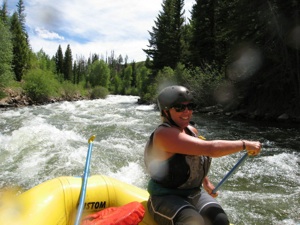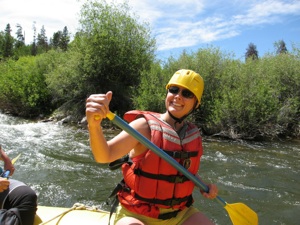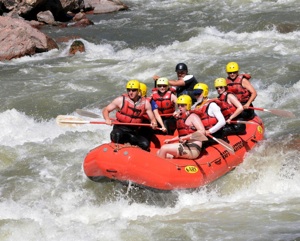The Dangers and Excitement of Whitewater Rafting
My RM Outdoor Adventures mystery series features the sport of whitewater rafting. The sleuth, Mandy Tanner, is a whitewater river ranger on the upper Arkansas River of Colorado, the most commercially rafted river in the United States. The huge volume of commercial and private boaters keep Mandy and her fellow river rangers busy performing rescues, checking licenses and safety procedures, clearing dangerous debris, etc. Mandy knows the rapids in the river like the back of her hand because, like most of the seasonal river rangers who work for the Arkansas Headwaters Recreation Area (AHRA), she used to be a rafting guide, taking tourists down various sections of the Arkansas on guided trips.
And I’m one of those tourists who love to rides the waves of Colorado’s whitewater rivers! Many people think the experience must be a terrifying one. But, the risks can be managed so the danger is minimized and the fun is maximized. First, to go whitewater rafting, you must:
-
1.Be in good health (heart attacks are the most common cause of rafting deaths).
-
2.Know how to swim.
Additionally, you MUST share your medical conditions (such as diabetes or asthma) with your rafting guide and bring along any essential medications or equipment (such as an inhaler or epi-pen). One rafting guide I interviewed said his first customer death on the river was a man who suffered from emphysema, didn’t divulge that condition on his paperwork, then left his medications in his car. The man fell in the cold water, was pulled back into the raft, but couldn’t catch his breath. That guide is still haunted by the man’s death, even though he could do nothing to help him and it wasn’t his fault!
Second, you should know your limits, based on physical condition and experience level. If you’re a first-time rafter, you should raft a river section that doesn’t have any rapids classified higher than Class III, Difficult. And if you do tackle Class III rapids, you should have a professional guide in your raft.
The International Scale of River Difficulty rates individual rapids and river sections on a six class scale. They range from Class I, Easy, with small waves with no obstacles, through Class II, Medium, up to Class V, Extremely Difficult, with long, violent rapids. The highest is Class VI, formerly classified as Unrunnable or Danger to Life or Limb, which are only attempted by expert kayakers after hours of scouting and with safety lines and rescuers standing by.
Family “float trips” usually stay in the Class I – III range and the roller-coaster adventure trips that I and other whitewater adventurers take are usually in the Class III-V range. I, however, have set my own upper limit at Class IV. You should always be prepared to swim any rapid your boat goes through, because the raft may flip or you may be tossed into the water. And I’ve decided that I don’t want to swim any rapid higher than IV, even though I’m a strong swimmer for my age.
The photos below were taken during a summer trip with my husband, my son and one of his friends, and our guide on the Blue River of Colorado, which was a Class II-III run and lots of fun.








